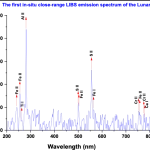Chandrayaan 3’s Rover Pragyan Discovers Oxygen on the Moon

ISRO has given this information in a tweet. According to ISRO, the Laser-Induced Breakdown Spectroscopy (LIBS) instrument mounted on the Chandrayaan-3 rover has made the first in-situ measurements on the elemental composition of the lunar surface near the south pole. These in-situ measurements clearly confirm the presence of sulfur(s) in the area. This discovery was not possible with the instruments on the orbiter.
LIBS is a scientific technique that analyzes the structure of materials by exposing them to intense laser pulses. A high-energy laser pulse is focused on the surface of a material, such as rock or soil. The laser pulse generates an extremely hot and localized plasma. The collected plasma light is spectrally decomposed and detected by detectors such as charge coupled devices. Since each element emits a specific set of wavelengths of light in the plasma state, the elemental composition of the material is determined.
ISRO has released a graph. The graph depicts the presence of several gases.
Preliminary analyses, shown graphically, have revealed the presence of aluminum (Al), sulfur (S), calcium (Ca), iron (Fe), chromium (Cr), and titanium (Ti) on the lunar surface. Further measurements revealed the presence of manganese (Mn), silicon (Si), and oxygen (O). Intensive investigation regarding the presence of hydrogen is underway.
LIBS payload to Electro-Optics System (LEOS)/ISRO, Bengaluru
Developed in the laboratory.
Source and photo: Bablu Chandra and ISRO

Journalist Space science.
Working with India’s leading news paper.
और अधिक जानें

